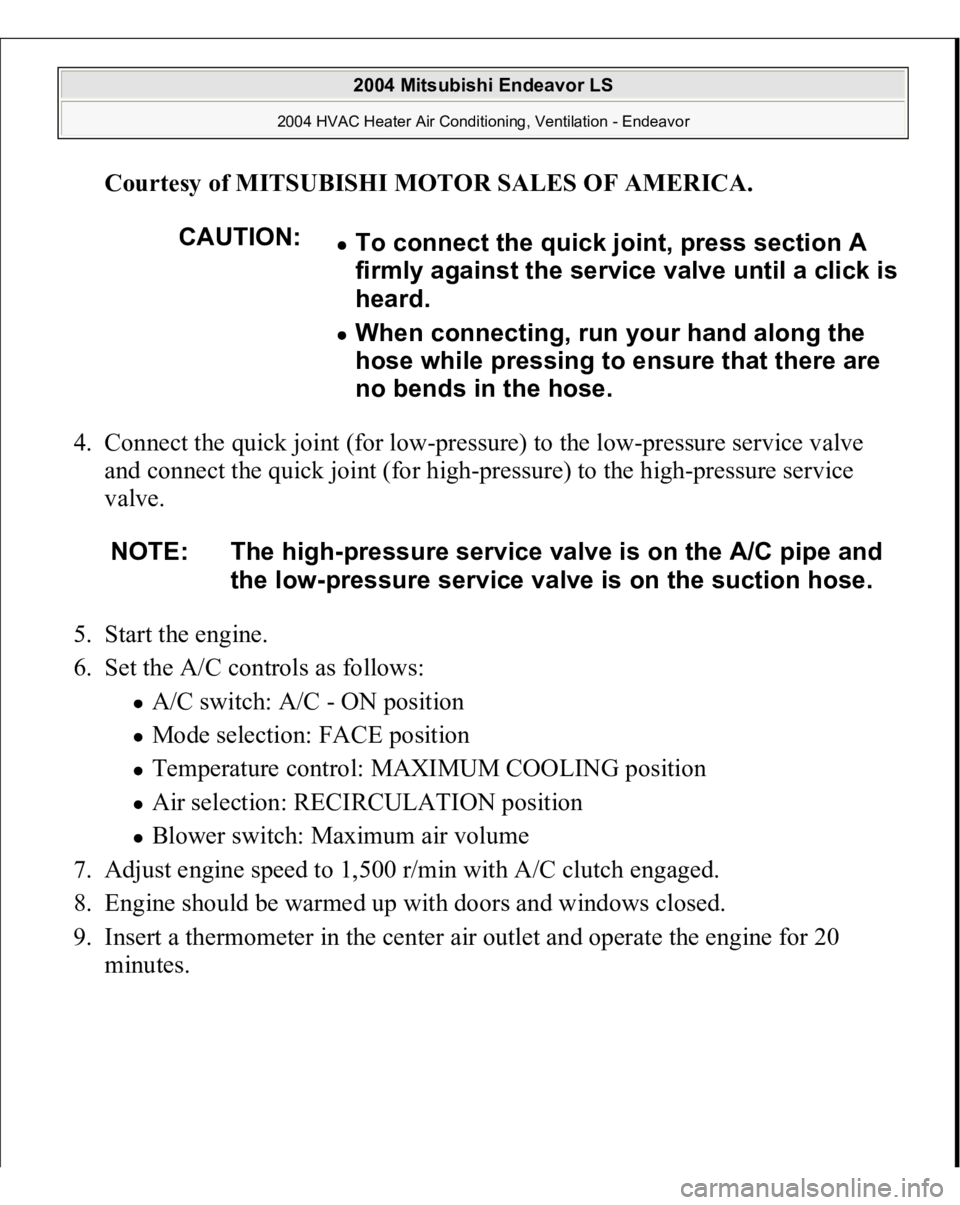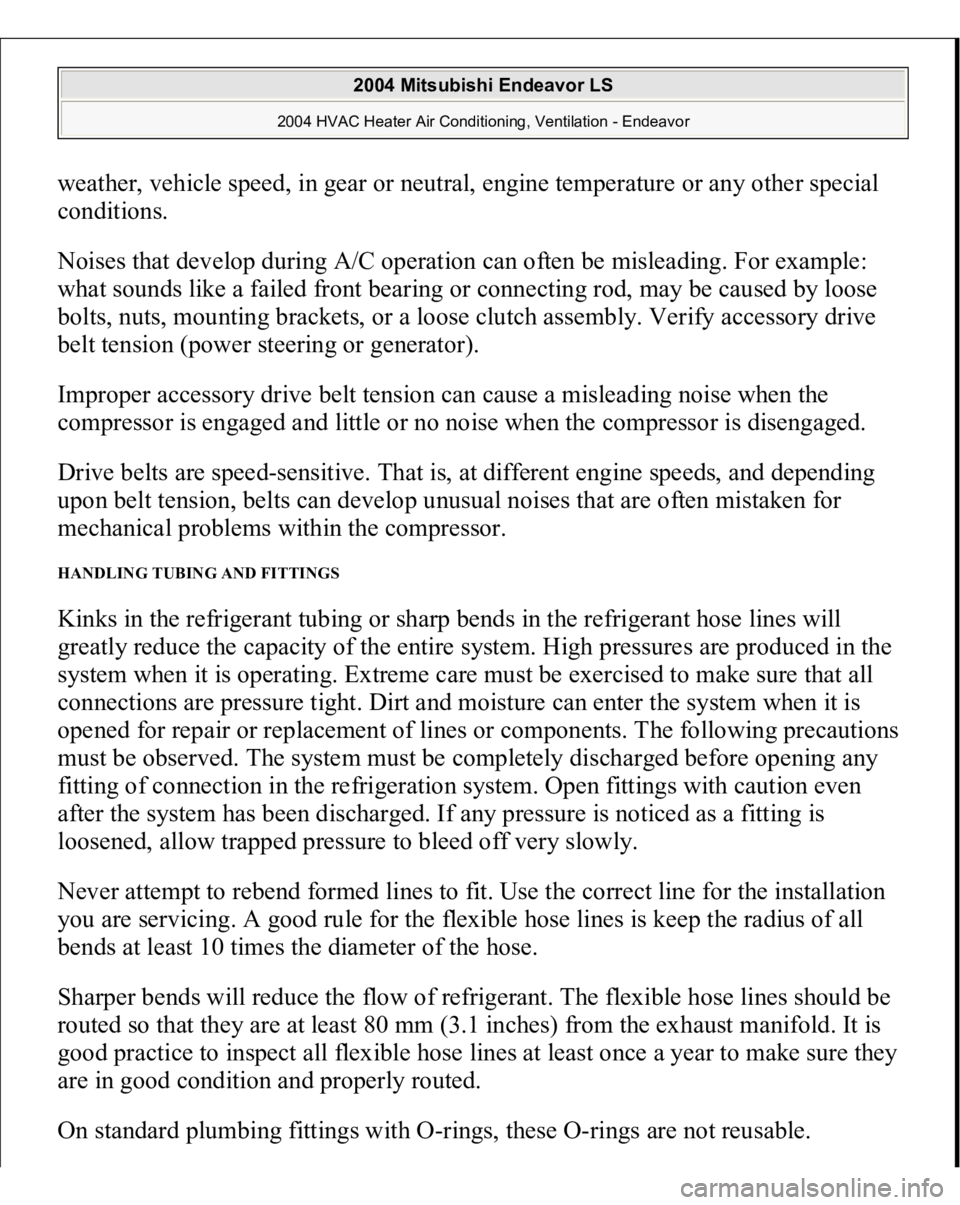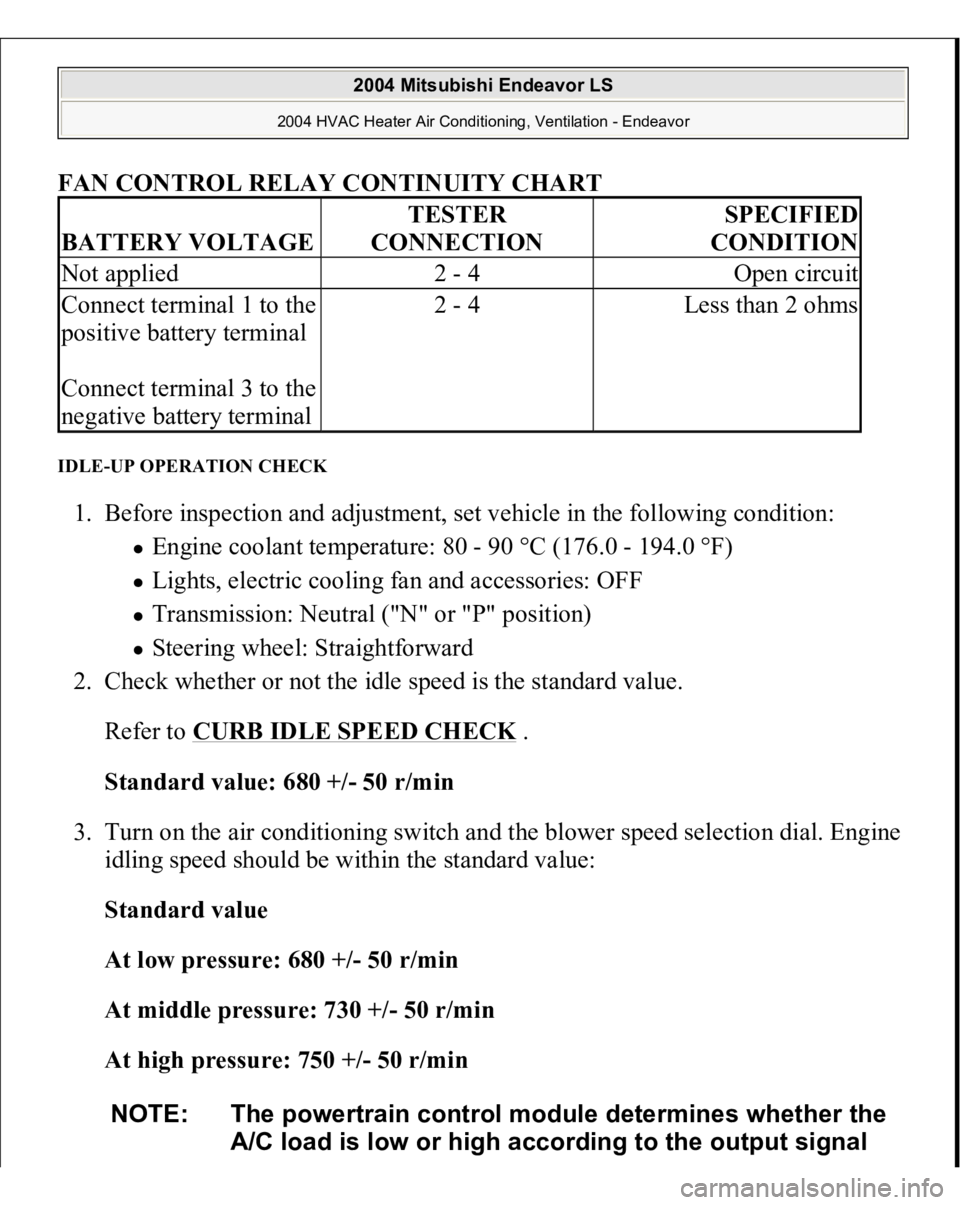Page 2232 of 3870
Fig. 163: Locating Connector C
-24
Courtesy of MITSUBISHI MOTOR SALES OF AMERICA.
STEP 18. Check the refrigerant temperature switch.
1. Dip the metal part of the cooling temperature switch into engine oil and
increase the oil temperature using a gas burner or similar.
CAUTION: Do not heat more than necessary.
2004 Mitsubishi Endeavor LS
2004 HVAC Heater Air Conditioning, Ventilation - Endeavor
Page 2239 of 3870
Fig. 170: Identifying A/C Pressure Sensor Connector
Courtesy of MITSUBISHI MOTOR SALES OF AMERICA.
3. Turn ON the engine and then turn ON the air conditioner switch.
4. At this time, check to see that the voltage of A/C pressure sensor terminal
No.2 reflects the specifications of the figure.
2004 Mitsubishi Endeavor LS
2004 HVAC Heater Air Conditioning, Ventilation - Endeavor
Page 2328 of 3870
NO:
Repair or replace the wiring harness. Refer to
HARNESS
CONNECTOR INSPECTION
. Check that the defogger system works
normally.
Fig. 239: Locating Connector F
-05
Courtesy of MITSUBISHI MOTOR SALES OF AMERICA.
STEP 16. Check the defogger.
1. Let the engine run at 2,000 r/min, and check the printed heater with the
battery fully charged.
2. Turn on the defogger switch, and use a voltmeter to measure the voltage in
each printed heater at middle point A on the rear window glass.
The value should be approximately 6 volts.
Q: Does the defogger work normally?
2004 Mitsubishi Endeavor LS
2004 HVAC Heater Air Conditioning, Ventilation - Endeavor
Page 2362 of 3870
Required Special Tools:
MB991658: Test Harness
1. Assemble a gauge manifold on the high pressure service valve.
2. Disconnect the A/C pressure sensor connector and connect special tool
MB991658 as shown in the illustration.
3. Turn ON the engine and then turn ON the air conditioner switch. Fig. 271: Identifying A/C Pressure Sensor Connector
Courtesy of MITSUBISHI MOTOR SALES OF AMERICA.
2004 Mitsubishi Endeavor LS
2004 HVAC Heater Air Conditioning, Ventilation - Endeavor
Page 2368 of 3870

Courtesy of MITSUBISHI MOTOR SALES OF AMERICA
.
4. Connect the quick joint (for low-pressure) to the low-pressure service valve
and connect the quick joint (for high-pressure) to the high-pressure service
valve.
5. Start the engine.
6. Set the A/C controls as follows:
A/C switch: A/C - ON position Mode selection: FACE position Temperature control: MAXIMUM COOLING position Air selection: RECIRCULATION position Blower switch: Maximum air volume
7. Adjust engine speed to 1,500 r/min with A/C clutch engaged.
8. Engine should be warmed up with doors and windows closed.
9. Insert a thermometer in the center air outlet and operate the engine for 20
minutes.
CAUTION:
To connect the quick joint, press section A
firmly against the service valve until a click is
heard. When connecting, run your hand along the
hose while pressing to ensure that there are
no bends in the hose.
NOTE: The high-pressure service valve is on the A/C pipe and
the low-pressure service valve is on the suction hose.
2004 Mitsubishi Endeavor LS
2004 HVAC Heater Air Conditioning, Ventilation - Endeavor
Page 2371 of 3870

weather, vehicle speed, in gear or neutral, engine temperature or any other special
conditions. Noises that develop during A/C operation can often be misleading. For example:
what sounds like a failed front bearing or connecting rod, may be caused by loose
bolts, nuts, mounting brackets, or a loose clutch assembly. Verify accessory drive
belt tension (power steering or generator).
Improper accessory drive belt tension can cause a misleading noise when the
compressor is engaged and little or no noise when the compressor is disengaged.
Drive belts are speed-sensitive. That is, at different engine speeds, and depending
upon belt tension, belts can develop unusual noises that are often mistaken for
mechanical problems within the compressor. HANDLING TUBING AND FITTINGS Kinks in the refrigerant tubing or sharp bends in the refrigerant hose lines will
greatly reduce the capacity of the entire system. High pressures are produced in the
system when it is operating. Extreme care must be exercised to make sure that all
connections are pressure tight. Dirt and moisture can enter the system when it is
opened for repair or replacement of lines or components. The following precautions
must be observed. The system must be completely discharged before opening any
fitting of connection in the refrigeration system. Open fittings with caution even
after the system has been discharged. If any pressure is noticed as a fitting is
loosened, allow trapped pressure to bleed off very slowly. Never attempt to rebend formed lines to fit. Use the correct line for the installation
you are servicing. A good rule for the flexible hose lines is keep the radius of all
bends at least 10 times the diameter of the hose.
Sharper bends will reduce the flow of refrigerant. The flexible hose lines should be
routed so that they are at least 80 mm (3.1 inches) from the exhaust manifold. It is
good practice to inspect all flexible hose lines at least once a year to make sure they
are in good condition and properly routed.
On standard
plumbin
g fittin
gs with O-rin
gs, these O-rin
gs are not reusable.
2004 Mitsubishi Endeavor LS
2004 HVAC Heater Air Conditioning, Ventilation - Endeavor
Page 2378 of 3870

FAN CONTROL RELAY CONTINUITY CHART
IDLE-UP OPERATION CHECK 1. Before inspection and adjustment, set vehicle in the following condition:
Engine coolant temperature: 80 - 90 °C (176.0 - 194.0 °F) Lights, electric cooling fan and accessories: OFF Transmission: Neutral ("N" or "P" position) Steering wheel: Straightforward
2. Check whether or not the idle speed is the standard value.
Refer to
CURB IDLE SPEED CHECK
.
Standard value: 680 +/- 50 r/min
3. Turn on the air conditioning switch and the blower speed selection dial. Engine
idling speed should be within the standard value:
Standard value
At low pressure: 680 +/- 50 r/min
At middle pressure: 730 +/- 50 r/min
At high pressure: 750 +/- 50 r/min
BATTERY VOLTAGE
TESTER
CONNECTION
SPECIFIED
CONDITION
Not applied
2 - 4
Open circuit
Connect terminal 1 to the
positive battery terminal
Connect terminal 3 to the
negative battery terminal
2 - 4
Less than 2 ohms
NOTE: The powertrain control module determines whether the
A/C load is low or high according to the output signal
2004 Mitsubishi Endeavor LS
2004 HVAC Heater Air Conditioning, Ventilation - Endeavor
Page 2380 of 3870
REMOVAL AND INSTALLATIONPre-removal and Post-installation Operation
Refrigerant draining and Refilling (Refer to
CHARGING
and
DISCHARGING
.)
Engine coolant Draining and Refilling (Refer to
13. ENGINE COOLANT
(CHANGE)
.)
Instrument Panel Removal and Installation (Refer to
REMOVAL AND
INSTALLATION
.)
Steering Column Shaft Assembly Removal and Installation (Refer to REMOVAL AND INSTALLATION
.)
2004 Mitsubishi Endeavor LS
2004 HVAC Heater Air Conditioning, Ventilation - Endeavor